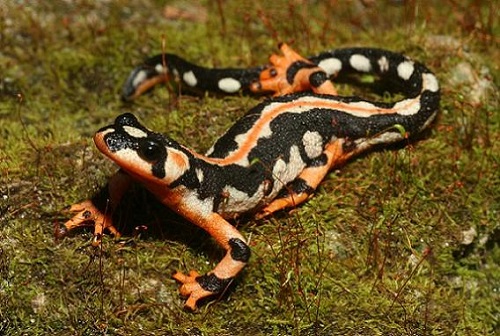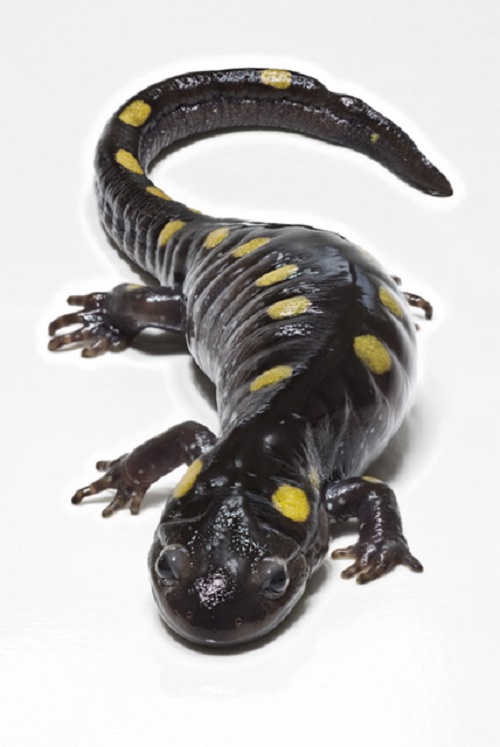Difference between Newt and Salamander
Amphibians, which is a term derived from an ancient Greek word that means “both kinds of life,” is the general classification of animals to which newts and salamanders belong. While newts and salamanders share many similarities, including the fact that they both belong to the order Cuadata, there are a few key differences between these two amphibians.
Definition
Newts are a type of salamander. Throughout its life, a newt undergoes three stages: an aquatic larva, a terrestrial juvenile stage (where it is referred to as an “eft”), and an adult stage.
Of the three orders of class Amphibia, salamanders belong to Cuadata, which is composed of nine families, 60 genera, and around 600 species. Newts are one of the species of salamanders, which also includes Congo eels, mudpuppies, and sirens.
Classification
Newts are salamanders that fall under the following genera: Triturus, Taricha, Cynops, Neurergus, Echinotriton, Euproctus, Pachytriton, Notophthalmus, Pleurodeles, Tylototriton, and Paramesotriton.
“True salamanders” fall under the Salamandra, Mertensiella, and Chioglossa genera.
Habitat
Some newt species live on both land and in water while others live exclusively in water.
Salamanders live in various habitats but most species need to keep their skin moist. They also have offspring in water so they need to be constantly near a water source.
Size
Newts come in a variety of sizes, but they are usually smaller than 8 inches or 20 centimeters.
With hundreds of species, salamanders come in an even greater variety of sizes. The largest species, which is the Japanese giant salamander can grow up to 1.8 meters of 6 feet while the smallest, which is the Thoriusarboreus can be as small as 1.7 cm or 0.6 inch. Most species, however, are around 16 cm or 6 inches long.
Physical characteristics
Newts have bodies that are lizard-shaped. They often have four legs and long tails. Some aquatic species have webbed feet and paddle-like tails. Their skin, which is often rough and coarse, are typically brighter in color to ward off predators.
The physical characteristics of salamanders are quite diverse. Some have four legs while some have two. They usually have long tails. Their skin is typically moist and often smooth.
Response to danger
When threatened, some newt species excrete toxins through their skin.
Some salamanders can drop their tails to ward off a predator.
Habits
Some newt species are diurnal while some are nocturnal.
Most salamanders are nocturnal or are active during cool times of the day.
Ability to regenerate body parts
Many newts can regenerate fully functioning limbs and some internal organs.
Many salamander species can regenerate their tails.
Summary of differences:
| Newt | Salamander | |
| Genera | Triturus, Taricha, Cynops, Neurergus, Echinotriton, Euproctus, Pachytriton, Notophthalmus, Pleurodeles, Tylototriton, Paramesotriton | Salamandra, Mertensiella, Chioglossa |
| Habitat | can be semi-aquatic to fully aquatic | often terrestrial although salamanders tend to stay in moist environments |
| Size | most species are usually smaller than 8 inches | most species are around 6 inches long, although the Japanese giant salamander can grow up to 6 feet long while the Thoriusarboreus can be as small as 0.6 inch |
| Body | most have lizard-shaped bodies | most have bodies that are long and slender |
| Number of legs | most have four legs | some have four legs while some have two |
| Characteristics of feet and tail | some have webbed feet and paddle-like tail | most have well-developed toes and longer, more rounded tails |
| How they breathe | most have well-developed lungs while completely aquatic species retain their gills | some species have lungs, some have gills, while some have neither as they breathe through their skin |
| Texture or skin | more often rough and coarse | more often slimier and more moist |
| Color | often brighter in color | some species have bright colors while some don’t |
| Response to danger | many are able to secrete toxins through their skin to discourage predators | most are able to drop their tails |
| Habits | many species are diurnal while others are nocturnal | often more active at night or during cool parts of the day |
| Ability to regenerate body parts | have the ability to regenerate fully functional limbs as well as some internal organs | some species can grow tails that have been shed due to an attack or a fight |
Newts are one of the 600 species of salamanders. Thus, while all newts are salamanders, not all salamanders are newts. The major distinction between these two amphibians lies on how they are classified. While newts belong to the Triturus, Taricha, Cynops, Neurergus, Echinotriton, Euproctus, Pachytriton, Notophthalmus, Pleurodeles, Tylototriton, and Paramesotriton genera, true salamanders belong to the Salamandra, Mertensiella, and Chioglossagenera.
- Difference Between Snowstorm and Blizzard - December 18, 2018
- Difference Between Foreword and Preface - October 4, 2018
- Difference Between Shade and Shadow - October 3, 2018
Search DifferenceBetween.net :
 Email This Post
: If you like this article or our site. Please spread the word. Share it with your friends/family.
Email This Post
: If you like this article or our site. Please spread the word. Share it with your friends/family.
1 Comment
Leave a Response
References :
[0]Heimbuch, Jaymi. “What’s the difference between a salamander and a newt?” Mother Nature Network. 6 Mar. 2017. Web. 29 Oct. 2017.
[1]Bradford, Alina. “Facts about Salamanders.” LiveScience. 29 Oct. 2015. Web. 29 Oct. 2017.
[2]Bradford, Alina. “Facts about Newts.” Live Science. 23 Mar. 2017. Web. 29 Oct. 2017.
[3]"Image Credit: https://en.wikipedia.org/wiki/Newt"
[4]"Image Credit: https://en.wikipedia.org/wiki/Salamander"




Newts are not “one of the species of salamander” as the third paragraph of this article states. Newts are an entire subfamily of salamander called Pleurodelinae. The term “species” is the narrowest taxonomic division (excepting subspecies). For example, the rough-skinned newt is a species.